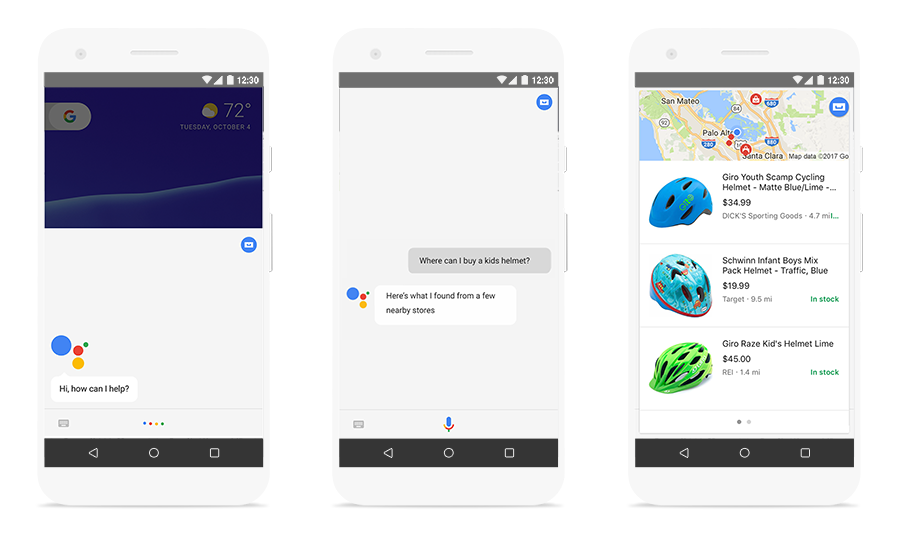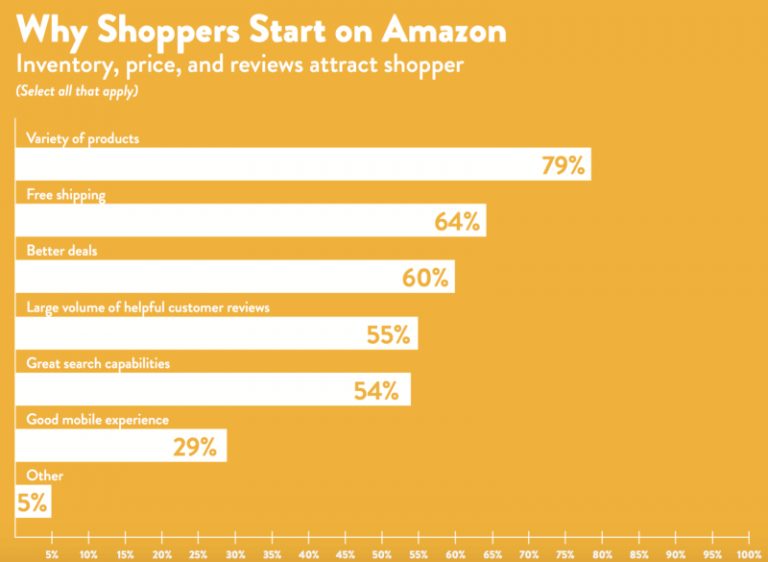In the battle with Amazon, Google is betting on its Shopping services to attract merchants and customers alike. A raft of product announcements has arrived just in time for the holiday season, including new ad formats and AdWords reports.
What do marketers need to know, and will these new products be enough to take market share back from Amazon?
Google has announced a variety of upgrades to its Shopping offering with a clear focus on improving the mobile experience, utilizing automation technologies to synchronize product information, and uniting voice search with ecommerce.
The search giant quite correctly pointed to “rising consumer expectations” as a driving force behind these innovations, especially as the Amazon juggernaut continues to gather pace.
Shopping seems the most suitable vehicle to compete with Amazon as an ecommerce business, but recent months have brought both successes and controversies for Google in this area, including:
- The hefty fine doled out by the EU to Google for antitrust violations.
- New partnerships with both Walmart and Target, with the aim of monetizing the growing voice search market.
- Rumors that a direct rival for the Amazon Echo Show is in the works and may even launch this year.
There is a lot for Google to figure out here, but the news that Amazon has become the number one starting point for product searches requires a reaction.
The survey results below provide useful context as we analyze the latest Google Shopping updates. The areas where Amazon excels (choice, seamless payment and shipping, price) are arguably areas of weakness for Google Shopping.
 (Source: Power Reviews)
(Source: Power Reviews)
To compete with Amazon means removing some of the friction from Google Shopping payments, providing more choice, and creating a model that promotes value for the consumer over aggressive bidding by advertisers.
The updates outlined below are certainly aimed at achieving these complex goals.
Showcase shopping ads
Showcase ads are targeted at the “exploration phase” of the purchase journey, in an allusion to the land Pinterest has been aiming to grab of late.
Google’s research has found that 40% of search queries exhibit a broad purchase intent, for example in searches such as [men’s shoes]. These queries could imply a range of different intents, from the informational to the transactional.
This new, swipe-able ad format gives brands significantly more space to highlight their products and benefits. It is therefore a fitting update for advertisers that want to capitalize on those broader search intents.

Google is encouraging advertisers to display lifestyle images that encourage users to further consider their products. This is a far cry from the pure, direct response model that underpins AdWords, but it is in keeping with the search industry’s attempts to broaden its horizons.
The official announcement from Google provides some clear insight into the functioning of these ads:
A Showcase Shopping ad appears on Google when someone searches with a more general term, such as “backpacks”. Then, Showcase Shopping ads show relevant products together with lifestyle images that you choose to represent your brand or business.
When someone clicks a Showcase Shopping ad, it expands revealing your products that are most relevant to the search terms they’ve used, which you connect to the ad using product groups. You can advertise a few dozen products or a whole category of your inventory with your Showcase Shopping ad.
We recommend that you start with a larger set of products (hundreds) first, and then create smaller groups as you see what works. To see how many products are targeted in a Showcase ad group, use the Products active column on the Product groups page.
Showcase Shopping ads use maximum CPE bidding, which means that you set the highest amount that you’re willing to pay for an engagement. Specifically, you’re charged when someone expands your Showcase Shopping ad, and spends 10 seconds within the ad or clicks a product or link in the expanded ad before then.
This new ad format will also be integrated with DoubleClick Search, Kenshoo and Marin, as well as AdWords.
Local inventory via Google Assistant
Google’s strategy has always been to get the products right and then find ways to make money from them once they know they have a hit with consumers. With regards to anything search-related, it has been pretty successful in this regard.
Voice search brings with is a whole new set of monetization challenges, but Google has kept its focus on getting the experience right before tackling these.
Google Assistant, the AI-driven and voice-enabled digital assistant at the core of so many Google products, can now be synced to the inventory of local stores. A consumer can therefore ask the Assistant where they can purchase a product nearby and Google can fetch the most relevant results, then display the locations via Google Maps. 
These are some important initial steps for Google as it grapples with the slick purchasing experience offered by Amazon’s Alexa assistant. Creating a seamless link between the Google Assistant and store inventory levels will start to bridge this gap and encourage some consumers to start their voice search journey with Google rather than Amazon.
Again, the idea is to encourage greater adoption of the Assistant rather than force mechanisms that could drive a short-term profit.
As long as brands have created a local inventory feed, their results could start showing up in these listings soon.
Automated pricing and product availability
Google has acted to resolve one of the seemingly minor, but persistent, frustrations with Shopping. In the past, it was possible for a consumer to see one price in the Google listing, then see another altogether when they arrived at the merchant’s website. Even worse, sometimes the product would be sold out by the time the consumer clicked through to buy it.
Launched on October 31st, automated pricing and product availability will ensure consistency between the ad and the merchant’s website. Advertisers will no longer need to add Schema.org mark-up to keep this in check.
Combined with a new payment system known as Pay with Google (first announced at Google I/O earlier this year), these innovations should create a much more seamless experience for consumers and a more insightful platform for advertisers. Furthermore, we should expect Pay With Google to integrate with the Google Assistant to make purchases even simpler for consumers.

Store visits measurement
Accurate measurement of the impact of online advertising on offline behaviors, and vice versa, has long been an ambition for Google and many other tech companies. We are slowly moving towards making this a reality, however, and Google has announced new measurement options for display advertisers.
The aim of this update is to tie impression-based data with store visits and therefore arrive at a conclusion about the effectiveness of display marketing campaigns.
Users who have opted into Location History measurement will share their data with Google, allowing more accurate reporting within AdWords and DoubleClick.
Three new reports will be available for advertisers:
- Time lag report — Shows the time between an ad click and a store visit
- Demographic report — Users can add store visits as a column to existing demographic reports
- New vs. returning customer report — This will show how many of store visits come from repeat customers.
Key takeaways
There is still a long way to go if Google Shopping is going to provide a better ecommerce experience than Amazon, but Google certainly has the resources and the ambition to do so.
All of these updates go some way to addressing existing issues with Shopping for consumers and advertisers, while also building on Google’s inherent advantages. Consumer behaviors can change quickly, as we have seen in the transition from Google to Amazon as the go-to destination for product searches.
If Google can encourage users to engage with its new hardware and its AI Assistant, that trend could certainly reverse in the near future.
With the holiday season soon upon us, we won’t have long to wait to see whether Google’s new Shopping products have their intended effect.
